We all know that small tanks are not ideal, but believe it or not, some fish are actually capable of thriving in 10-gallon fish tanks. Whether you’ve found yourself stuck with a smaller tank due to space constraints, or are simply curious about what these hardy fish species may be, this article will tell you everything you need to know about the best fish for 10-gallon tanks and how many you can fit!
Best Fish for 10 Gallon Tank
Great! Now that you have a general idea of how to stock a 10-gallon tank, we can move on to some of our recommended species. These fish have been chosen for their size and ability to adapt to a smaller tank, but you’ll still need to make sure the numbers make sense. In other words – no overstocking!
With that said, here are some of our top fish recs for a 10-gallon tank:
1. Betta Fish
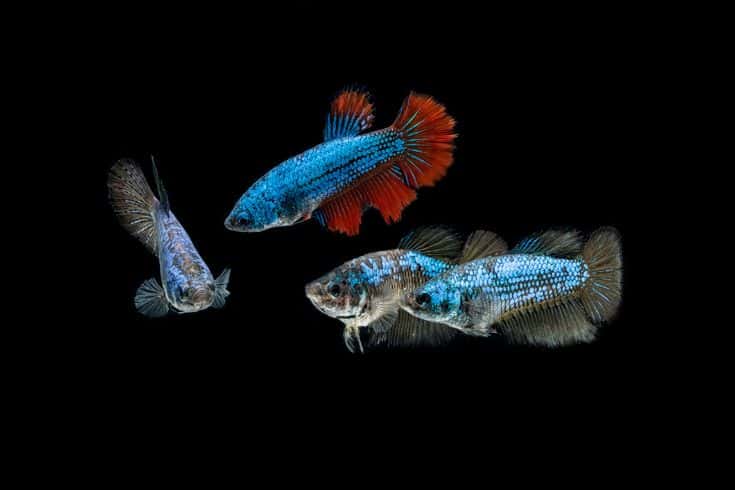
- Care Level: Easy
- Temperament: Curious, Exploratory
- Water Conditions: 76 to 85° F
- Max. Size: 3 inches
- Family: Gourami
- Lifespan: 2-3 years
Bettas are probably the quintessential beginner fishes for most people. They are active fish with beautiful colors, and will be perfectly at home in a 10-gallon fish tank. If you intend to keep female bettas, you can house up to 3 in this setup. But if you intend to keep males, you will need to keep them solo. This keeps aggressive behavior at bay, which ultimately protects your fish.
10 gallons may sound like too much space for a single fish, but we think it provides just the right amount of swimming space for your active bettas. Plus, the extra space prevents ammonia levels from building up too quickly. With the right choice of lighting and careful plant selection, you’ll be able to create a 10-gallon aquarium that looks every bit as grand as a 120-gallon mega tank.
2. Dwarf Gourami
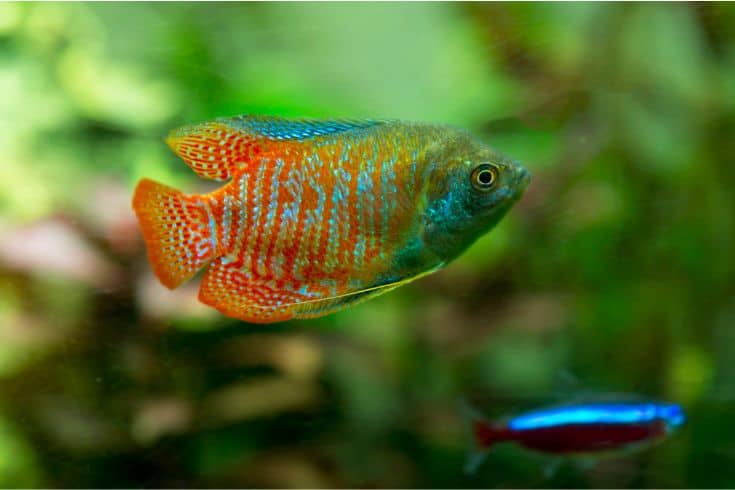
- Care Level: Intermediate
- Temperament: Generally peaceful, may act aggressively around other colorful fish
- Water Conditions: 72 – 82°F
- Max. Size: 3.5 inches
- Family: Gourami
- Lifespan: 4-5 years
Despite the wide variety of fish within the species, gouramis generally aren’t the types of fish you’d want to keep in a 10-gallon tank. However, the Dwarf gourami is possibly the only exception to the rule. These little guys only reach a maximum of 3.5 inches in size, which means that you can comfortably house up to 3 dwarf gouramis in a 10-gallon tank.
Like most gouramis, the Dwarf species can be aggressive around other colorful fish. So, if you intend to house them in a community aquarium, you’ll need to pick your tankmates carefully. Personally speaking, I like pairing dwarf gouramis with a bottom feeder with muted colors. The cory catfish comes to mind. These guys will keep your tank clean, while giving your dwarf gouramis some company!
3. Neon Tetra
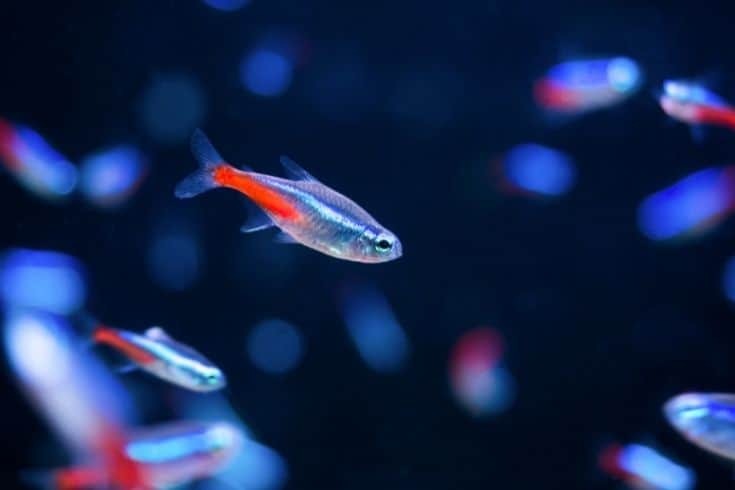
- Care Level: Easy
- Temperament: Peaceful schooling fish
- Water Conditions:
- Max. Size: 2 inches
- Family: Characidae
- Lifespan: 3 years in captivity
With their distinctive neon blue stripes and bright red colors, the neon tetra is possibly the most iconic fish in the hobby. And who could blame us for fawning over these little guys? These beautiful fish look amazing and have peaceful natures to boot. This makes them perfect for community tanks, as long as their tankmates aren’t fazed by their bright colors!
Like most omnivores, neon tetras will happily chow down on fish flakes, frozen food, and plant-based fish foods you feed them. Do you have some baby brine shrimp in your freezer? Your neon tetras will go crazy with glee. Are you hoping to feed them some algae wafers? Please go right ahead. Their easy-going nature makes these hardy fish perfect for those of you with beginner tanks.
4. Zebra Danio
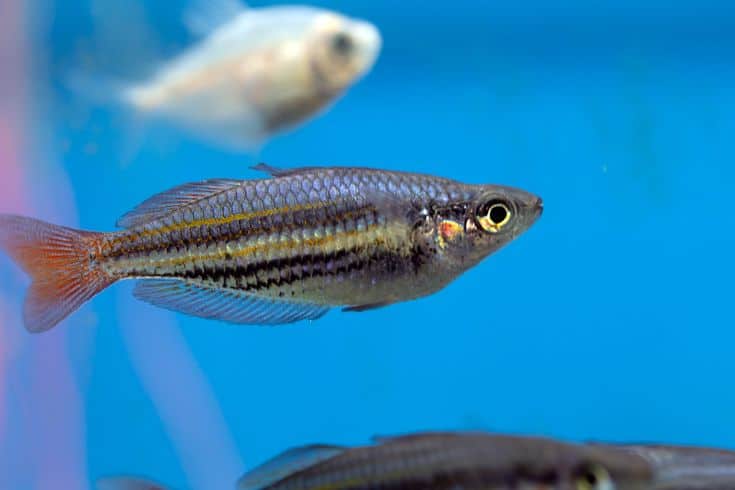
- Care Level: Easy
- Temperament: Peaceful
- Water Conditions: 70° and 78° F
- Max. Size: 2.5 inches
- Family: Minnow
- Lifespan: 3.5-5.5 years
What’s small, adorable, and reminds one of a certain black and white animal? Enter the zebra danios! These pint-sized fish grow up to 2.5 inches in length, which means they’ll be perfectly at home in your 10-gallon tank. Sporting a bold black and white striped pattern, they look just like tiny zebras! And when it comes to personality, these fish are both friendly and peaceful, making them great for any tank.
To keep your zebra danios healthy, you’ll need to provide them with quality flake food, as well as plenty of hiding spots. They also prefer an aquarium with plenty of plants and places to explore. With the right environment and care, these fish can live up to five years, providing you with years of companionship. Trust us – once you’ve welcomed a few of these little cuties into your aquarium, you’ll be glad you did!
5. Fancy Guppy
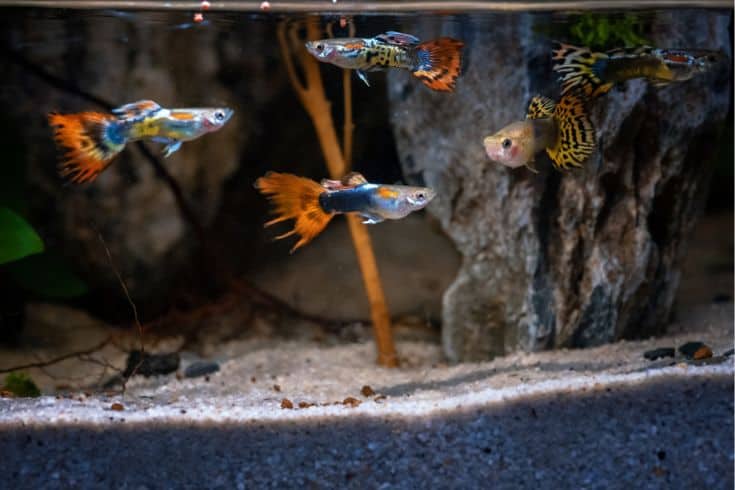
- Care Level: Easy
- Temperament: Friendly, curious
- Water Conditions: 72-82 °F
- Max. Size: 2.5 inches
- Family: Livebearers
- Lifespan: 2 years
You didn’t think we would leave out fancy guppies, did you? We know – this recommendation is a little obvious. But fancy guppies are popular for a reason! Thanks to generations of selective breeding, these guys come in a stunning array of colors and tail shapes. No matter what your desired tank aesthetic may be, you’ll be able to find a fancy guppy that fits right in, lending some pizzazz to the tank.
Amazing as their appearance may be, the true appeal of fancy guppies actually lies in their resilience and personality. These fish are easy-going in every sense of the word. They’re undemanding when it comes to water parameters, and also make pretty relaxed, friendly tank mates for most community fish. Just be sure to do your part by carrying out frequent water changes, and feeding them a nutritious diet!
6. Platy
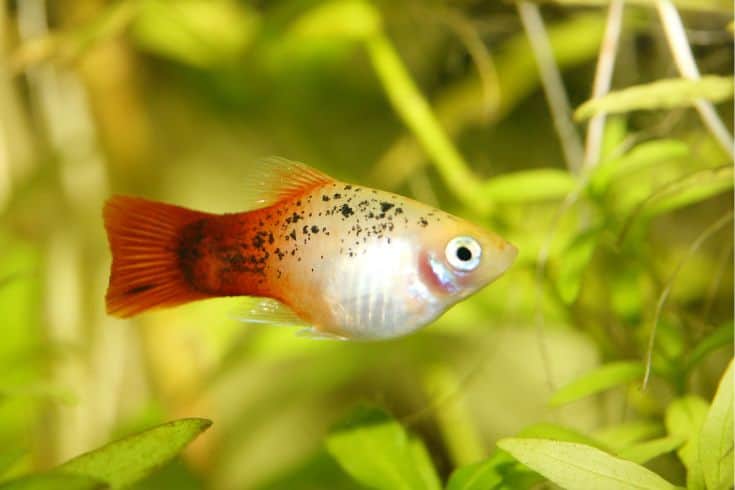
- Care Level: Easy
- Temperament: Peaceful, gets along well with other fish
- Water Conditions: 70–77°F
- Max. Size: 2.8 inches
- Family: Livebearer
- Lifespan: 3 years
You wouldn’t know it at first glance, but platies are actually related to fancy guppies! Like their cousins, platies are colorful and small enough to thrive in 10-gallon tanks. And because these are livebearers, you can expect them to be a little hardier. This means they’ll tolerate a wide range of water parameters, making them more forgiving pets for first-time fish keepers.
To add to their list of versatile traits, platies are also omnivores. This means that they will eat anything from algae wafers to brine shrimp, as long as you obtain them from reputable sources. We recommend using commercial fish flakes or pellets as your platies’ main food source. This ensures that their core nutritional needs are met. Then, you can supplement their diet with plants or proteins as you see fit!
7. Common Molly

- Care Level: Easy
- Temperament: Peaceful, easy-going
- Water Conditions:
- Max. Size: 6 inches
- Family: Livebearer
- Lifespan: 4 years
Are you looking for fish that look good, while lending plenty of personality to your tank? Believe it or not, the common molly is one of our favorite picks! These fish love exploring their surroundings and will thrive in an aquarium with lots of decor to keep them entertained. They also come in a wide range of colors, ranging from powder blue to bright red. This makes them perfect for people who love a colorful setup!
Like many livebearers, mollies prefer slightly alkaline water. This means two things: you’ll need to keep your tank very clean, because decomposing plant and animal matter can cause the pH to plunge. Secondly, you may need to invest in pH-raising substrates. Thankfully, these can be found in most pet stores. Baking soda may also work in a pinch, though you’ll need to be extremely careful not to overdo it.
8. Least Killifish
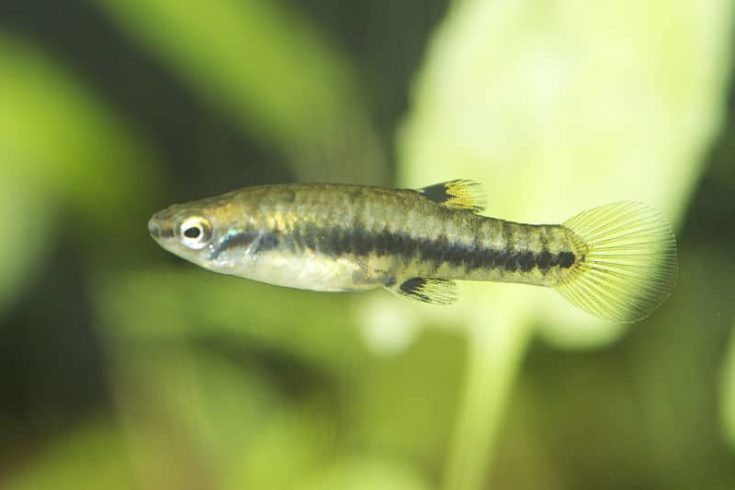
- Care Level: Easy
- Temperament: Shy and peaceful, but needs to be kept in schools
- Water Conditions: 66-75°F
- Max. Size: 1.4 inches
- Family: Livebearer
- Lifespan: 3+ years
With a maximum size of just 1.4 inches, the least Killifish is known for being the tiniest livebearer in the fishkeeping hobby. This, of course, makes them perfect candidates for a 10-gallon tank. This amount of space allows you to keep up to 7 of these guys together, which is perfect for them. As you may have guessed, these shy little guys are most at home in a school of their own species.
Of course, you can also opt to keep fewer least killifish in favor of a more diverse array of fish. Just keep in mind that these are true shoaling fish, so you’ll need to aim for a school of at least three fish. Once you’ve checked that requirement off the list, you can add any other compatible species to your tank! It’s best to stick to fish that are similarly sized, as they are less likely to chow down on your least killifish.
9. Pencilfish
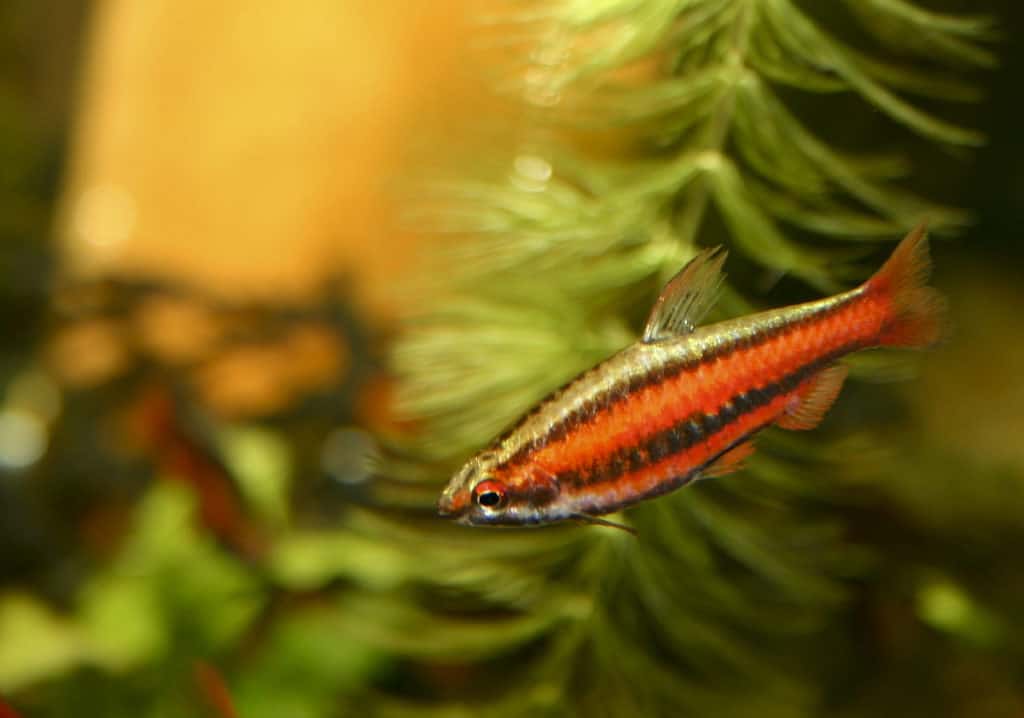
- Care Level: Easy
- Temperament: Peaceful
- Water Conditions: 72° to 82°F
- Max. Size: 8 inches
- Family: Lebiasinidae
- Lifespan: 5 years
Pencilfish are aptly named as such because of their long, slender bodies and pointed snouts. Together, these features resemble the barrel and tip of a sharpened pencil, giving them their common name. Depending on the type of pencilfish you opt for, you may get fish that are either mid or surface dwellers. My personal favorite is the diptail pencilfish, which swims at an interesting 60-degree angle!
Because pencilfish are schooling fish, it’s important to keep them in groups of at least four. A 10-gallon tank allows you to accommodate a school of pencilfish, but nothing more. So, if you want your pencilfish to be part of a larger community tank, we recommend sizing up. Otherwise, a species-only tank will work just fine! In fact, species such as the purple pencilfish may actually prefer species-only setups.
10. Otocinclus Catfish (Dwarf Suckers)
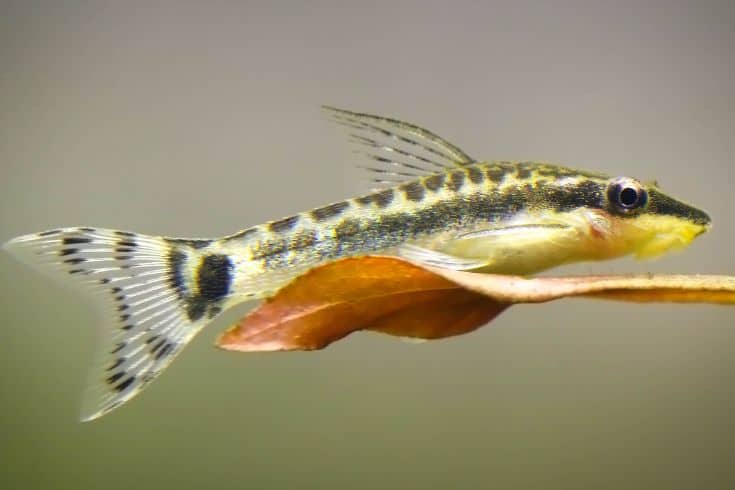
- Care Level: Easy
- Temperament: Peaceful and calm
- Water Conditions: 72-82°F
- Max. Size: 2 inches
- Family: Armored catfishes
- Lifespan: 7 years
The otocinclus catfish is probably one of my favorite fish in the aquarium trade. For one, these are awesome algae eaters that will pull their weight in keeping my tank clean. These fish are happy to munch on any algae growing on the substrate, tank walls, and plants, which leads to a more aesthetically appealing tank. The fact that algae keeps these fish nice and full, is a nice little bonus.
In addition, otocinclus catfishes also have very basic care requirements. Don’t get us wrong – this doesn’t mean that you can stop taking care of your fish altogether. What it does mean, however, is that you can rest assured knowing that these fish will tolerate minor fluctuations in pH and temperature with relative ease. These fluctuations are difficult to prevent, so having hardy fish can give you some peace of mind.
11. Pygmy Corydoras
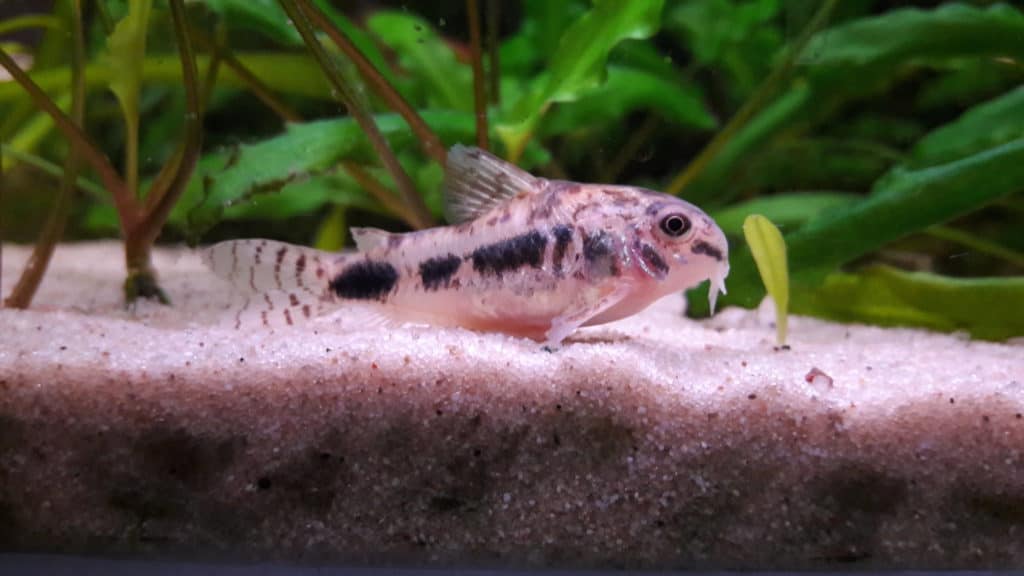
- Care Level: Easy
- Temperament: Peaceful, relaxed
- Water Conditions: 72–79 °F
- Max. Size: 1.3 inches
- Family: Callichthyidae
- Lifespan: 3 years
If you’re anything like us, the idea of a school of cories swimming gaily around your 10-gallon tank is a dream come true. Pygmy cories are one of the most popular fish in the aquarium hobby, and for a good reason. They are small, peaceful, and active fish that will bring a lot of life to your tank. They are also easy to care for and can tolerate a wide range of water parameters.
A school of six pygmy cories is the ideal setup for a 10-gallon tank. Cories prefer to be kept in groups, so adding a few more to the school is always recommended. To ensure that your little fish are happy and healthy, provide them with plenty of hiding places and a soft, sandy substrate. You should also provide them with plenty of live or frozen foods, as they are omnivores and need a variety of foods to stay healthy.
12. Kuhli Loaches
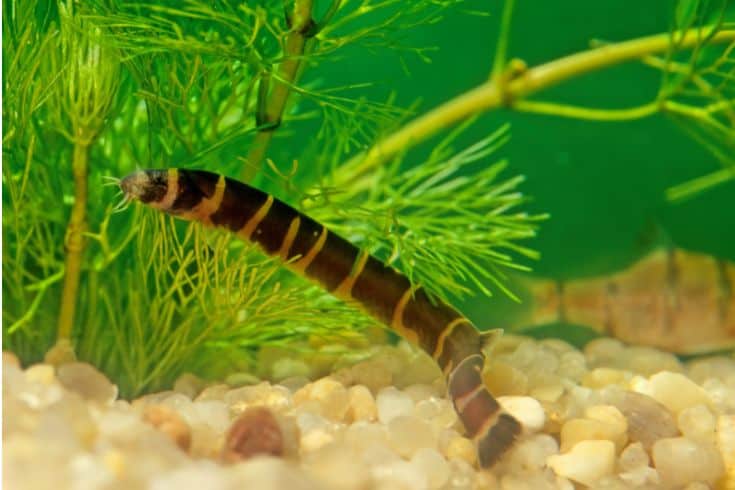
- Care Level: Easy
- Temperament: Mellow and peaceful
- Water Conditions: 75 – 86°F
- Max. Size: 4 inches
- Family: Cobitidae
- Lifespan: 10 years
We are super excited about introducing this unique tropical fish species. Kuhli loaches have long, slender bodies that remind one of the eels. However, they are actually fish belonging to the Cobitidae family, and have much of the same characteristics as other mellow loach species. Though these fish are usually kept in a larger aquarium, you can keep up to 3 Kuhli loaches in a 10-gallon tank.
To keep these fish happy, make sure to keep the water hardness relatively soft. These fish enjoy water that’s 5.dGH and under, as these conditions replicate their natural environment. As fish that hails from Indonesia and the Malay peninsula, they are also accustomed to tropical climates. Therefore, a good heater is a must if you want to keep these fish healthy and happy.
13. Nerite Snails
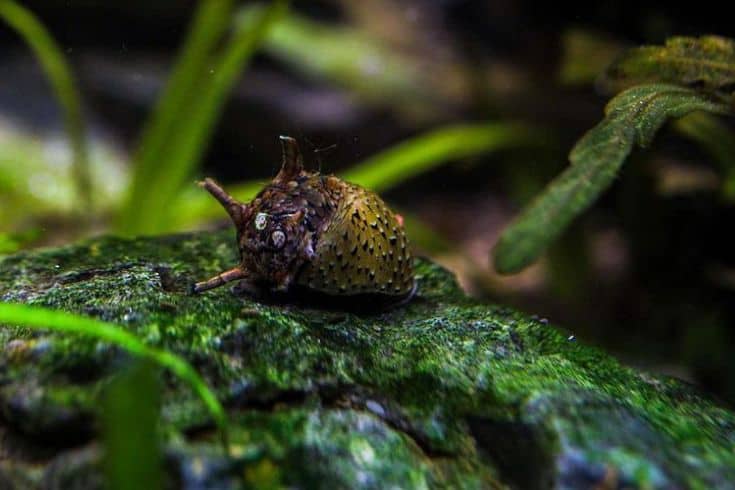
- Care Level: Easy
- Temperament: Peaceful
- Water Conditions: 72°-78°F
- Max. Size: 1 inch
- Family: Neritidae
- Lifespan: 1 year
The next entry on our list isn’t a fish at all. The nerite snail is a species that thrives in brackish water, and will reproduce rapidly under the right circumstances. Though it may seem a little odd to include them on our list, we think they’re the perfect alternative if you’re looking for a tankmate that’s a little different. These guys are peaceful, interesting, and will keep your tank algae-free. What more could you ask for?
Of course, you’d need to take certain precautions when introducing nerite snails to your tank. For one, you need to make sure that your fish do not eat them as a tasty treat. This is especially the case if you have community fish that are significantly larger than these snails. Try to stick to similarly sized peers, i.e., fish on the tinier end of the scale. And whatever you do, please avoid aggressive fish!
14. Cherry Shrimp
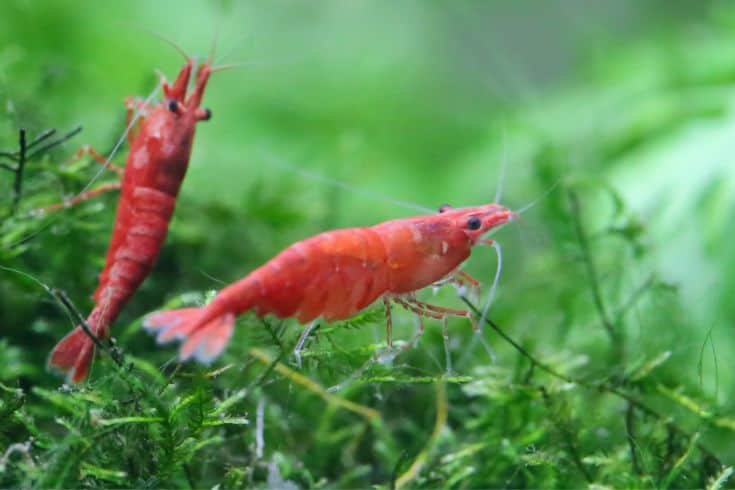
- Care Level: Easy
- Temperament: Active, Peaceful
- Water Conditions: 65°-75°F
- Max. Size: 1.5 inches
- Family: Atyidae
- Lifespan: 2 years
The cherry shrimp is yet another entry that isn’t an aquarium fish. However, they do make pretty awesome companions for your fishy friends. These handy little scavengers will have a great time feasting on uneaten food and algae in your tank, keeping ammonia and nitrate levels low. Of course, they’re not substitutes for a good filter and regular water changes. But think of them as handy little helpers.
It is best to keep your cherry shrimp with other peaceful fish, particularly those that are smaller. In our opinion, the biggest fish you should keep with these little guys should be around 3 inches in size. In addition, it’s important to note that these crustaceans are very sensitive to poor water quality, so please invest in a reliable power or canister filter to keep things running smoothly in your tank.
15. Ghost Shrimp
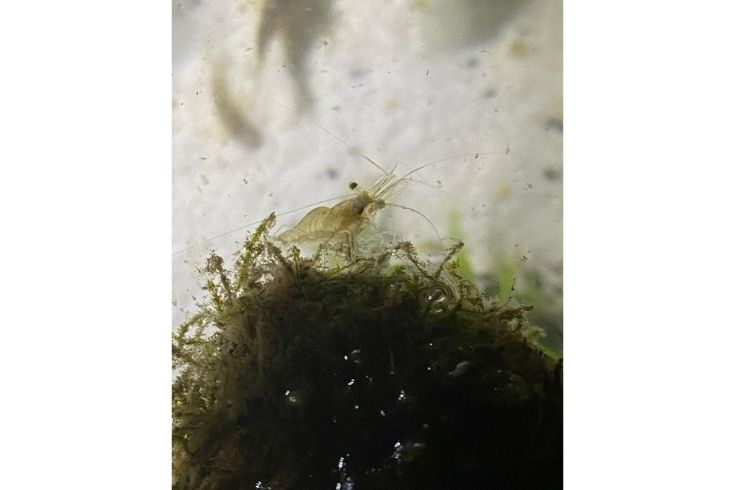
- Care Level: Easy
- Temperament: Peaceful and will keep to themselves
- Water Conditions: 72 – 82°F
- Max. Size: 2 inches
- Family: Palaemonidae
- Lifespan: 1 year
Finally, we have the ghost shrimp. Of the many amazing varieties of underwater creatures we have covered on this list, the ghost shrimp takes the cake for looking the most unique. While other creatures may compete with one another to see who has brighter colors, the ghost shrimp sits out of the competition altogether, standing out with its fully translucent, colorless body.
Because ghost shrimp are so tiny, you can easily keep them in a 10-gallon tank. In fact, many in the aquarium trade use 5-gallon tanks when they’re keeping a species-only tank. A 10 or 20-gallon tank, however, allows you to keep your ghost shrimp with other freshwater fish. This allows you to witness the symbiotic relationship that ghost shrimp can form with multiple species of fish.
Tips On Stocking A 10-Gallon Tank
Before diving into our species recommendations, it’s vital that you understand some of the basic principles behind stocking a 10-gallon tank. After all, there’s no point in opting for the perfect species if you’re going to have too many fish for comfort! Here are some of our top tips on tank stocking:
“One Inch of Fish Per Gallon of Water”
Our first tip for stocking a 10-gallon tank is to adhere to the “one inch of fish per gallon of water” rule. In essence, this rule posits that for every gallon of water in your tank, you should not have more than one inch of fish. This rule allows you to have fewer tiny fish in a tank, or one larger fish, but not a combination of the two.
This rule assumes that the bioload of the fish is proportional to their size. While we think this is a fair assumption, it is not completely accurate. For instance, goldfish and clown loaches have similar lengths, but goldfish have a much larger bioload due to their high waste production. Be that as it may, this is still a good, general rule for people who are completely new to the hobby.
Consider Your Fish’s Adult Size

When stocking a 10-gallon tank, it’s important to consider the adult size of the fish you plan to keep. Oftentimes, the fish purchased from pet stores are very small, but can quickly become too large for the tank. For instance, a plecostomus usually only measures 2-3 inches when purchased but can reach up to 18 inches in length when fully grown.
So, when stocking a 10-gallon tank, make sure to research the adult size of the fish that you plan to keep. Otherwise, you may find yourself having to upgrade to a larger tank sooner than expected.
Err On The Side Of Under-Stocking
Say you’ve decided to follow the “inch-per-gallon” rule. Alas, the total length of your fish is just slightly over the 10-inch mark. What do you do? Our advice is to err on the side of understocking the tank. This means that you should either choose to reduce the number of fish in your tank, or opt for a larger tank if need be.
We know this is cumbersome. But think about it – it’s much better to have a tank with fewer fish and a healthy environment than to have a tank that’s overstocked with fish and an unhealthy environment.
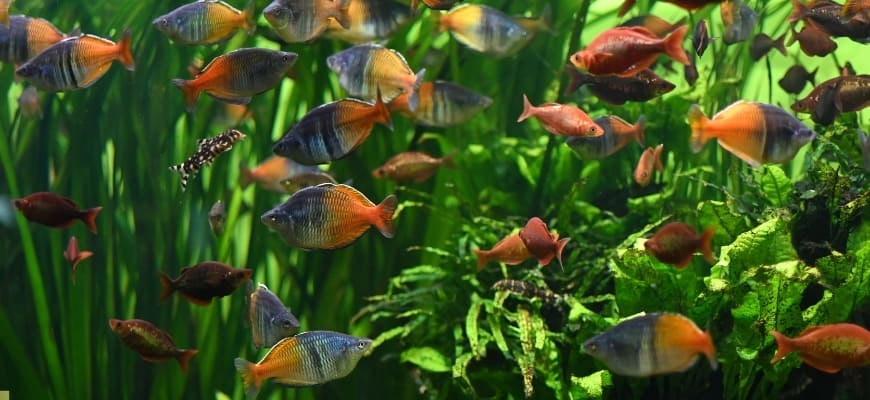
Final Thoughts
And there you have it! We hope you enjoyed this list of best fish for 10-gallon aquariums, and found our guide helpful. If you know someone who would benefit from this article, do us a favor and share it with them! We want to reach as many people as possible, and we can’t do it without your support. Thanks for reading, and happy fishkeeping!
My 20 gallon freshwater tank came with sand and rooted plants, they aren’t doing so well now but I just started a light on them,,and filled my tank with all new water 1 week ago. Hoping the bacteria from previous owner is still there. My question is do I add any chemicals and start checking the ph etc. before adding any fish? Thanks
Hi, and thanks for the question! It sounds likely that your tank should still have a nice population of “good” aquatic bacteria in the sand and around the plant’s roots, so you probably won’t experience the wild swings in pH and ammonia we usually see during the New Tank Syndrome stage.
There will still be small changes, though, as the chemistry in the tank adjusts after you add your fish to the community. The ammonia levels may initially rise a little higher than ideal, since the tank hasn’t had any fish inside to feed the bacterial growth for a while, and it may take a couple of weeks for new bacteria to fill in the gaps.
I would take baseline measurements of the tank’s pH, ammonia and nitrite before adding any fish to the tank, and then track it for at least a couple of weeks after adding fish to be sure you don’t have any problems with your chemistry. As to adding chemicals to your tank, obviously you’ll need to use a good water conditioner to remove the chlorine/chloramines from the tap water. Until you test the other levels and have fish in your tank, though, it’s hard to know if you’ll also need to use anything else. It can’t hurt to keep a small bottle of an ammonia-removing product handy in case you see a spike.
The other thing I’d recommend is adding a liquid fertilizer to the water and/or fertilizer tabs to the sand around the roots to help boost your plant’s growth. The light will certainly help as well, but sandy substrates are often devoid of the nutrients plants need. Let us know how your new tank is coming along!
Hi, what kind of live plants can be in a 10 gallon tank with the fish? Thank you
Hi! How do I find good information on how to clean the tank and how often, what kind of fish goes together? Thank you
I just got the Floval 9 gallon but after reading your article I think I need to go bigger! I got that tank to be a desktop and was told by TWO aquarium stores I’d be fine with 5 neon tetras, 3 guppies and a white albino catfish. I just felt in my gut that was too many! Plus, with the filtration system on the back I’d have to move the tank forward to change out the filter. Nah huh! I’m going to take it back and exchange it for a 20 gallon because I have a vision for the look I want and I want my fish community to be healthy and happy. I’m glad I found your article!
I have a 10 gal. tank with three very small fish two of the fis h are black and hold speckled fat tummies the other is a real small all black I am not sure what they are. Today I noticed at least three tiny baby all black darlings, at this point I don’t have a clue what to do please let me know, so I can save these babies.😯 thanks for any help you can give me.
Quick history with my 10 gallon freshwater tank. Sad story but my wife and I were away for a weekend, we lost power, so nothing with the tank worked, the AC didn’t kick on & our existing tank with 3 neon tetras & 1 clown pleco each passed away. The 2 nerite snails we had survived. This happened about 1 month ago. I have 2 anubias plants, 1 java fern & 2 pieces of driftwood along with a small cave, 2 air stones & gravel substrate. I perform weekly water changes (about 25%), gravel vacuuming & water testing. All of my levels (nitrates, pH, etc) are in great condition.
After some research, I decided I’d like to have a dwarf gourami as my feature fish with others in my community tank. So I purchased a powder blue dwarf gourami along with a handful of smaller water lettuce to float at the top. I’m looking to keep it this way for at least another month so the tank can cycle again before adding any other fish. I’m hoping you can provide some input/advice on what these other fish can be. I’m considering one species of the following; either neon tetras, harlequin rasboras, or chili rasboras (I’m open to other suggestions as well). Not sure if I need more of a cleanup crew with the 2 nerites I already have. I understand those are all schooling fish so I’m concerned with the amount of either fish I can get as I don’t want to overcrowd the tank. So please let me know about how many of each you’d recommend to go along with my dwarf gourami & 2 nerite snails. Thanks in advance & loved the article, very informative!